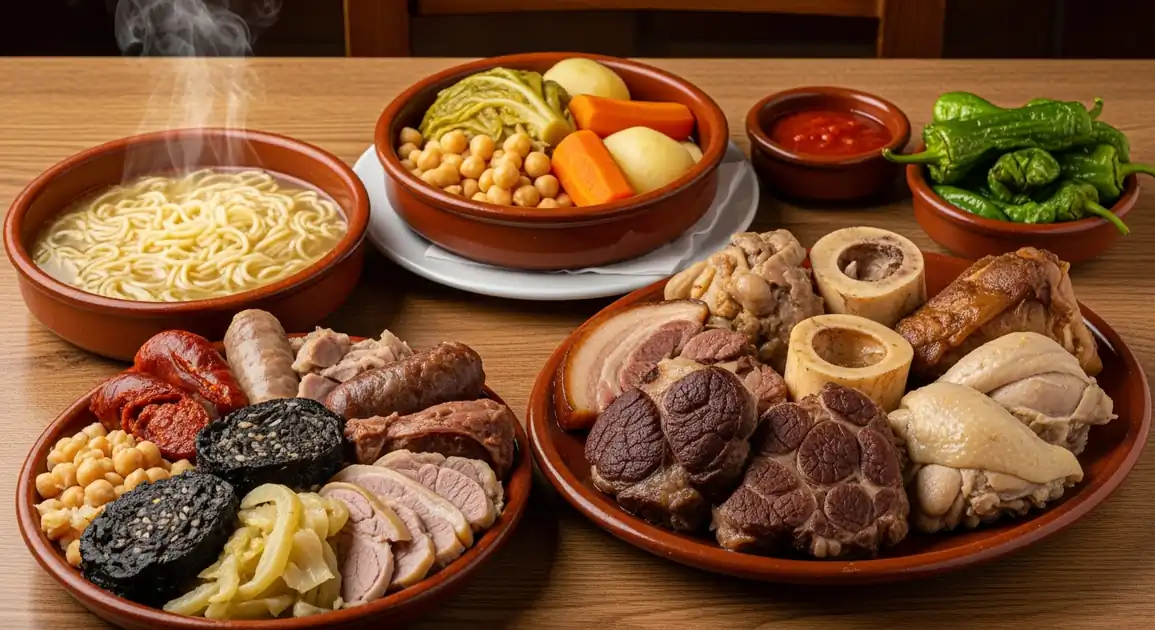Cocido Madrileño
Cocido Madrileño

Description
Madrid is the undisputed home of Cocido Madrileño. Numerous traditional restaurants ('casas de comidas', 'tabernas') specialize in this dish, particularly during the winter months. Experiencing Cocido in Madrid involves embracing the ritual of the three 'vuelcos' and enjoying a hearty, historic meal central to the city's culture.
Dietary Information
Serving information
Serving style
Strictly served in three courses ('vuelcos'). Served piping hot. Portions are typically very generous.
Quick facts
Lunch only, 1 PM - 4 PM typically. Check specific restaurant hours.
Safety Tips
What to Look For
-
All three courses served piping hot
Ensures the food is freshly prepared or properly held at safe temperatures, critical for a slow-cooked dish.
-
Tender meat and fully cooked chickpeas/vegetables
Indicates thorough cooking, essential for safety and digestibility.
-
Reputable restaurant known for Cocido
Established places specializing in Cocido usually maintain high standards of preparation and ingredient sourcing.
-
Clear, flavorful broth (first course)
A well-made broth is a sign of quality preparation, although cloudiness isn't necessarily a safety issue.
What to avoid
-
Lukewarm servings
Food served at improper temperatures poses a significant food safety risk.
-
Undercooked chickpeas or tough meat
Could indicate insufficient cooking time, potentially compromising safety and quality.
-
Restaurants with poor hygiene ratings or reviews
General cleanliness is paramount for food safety.
-
Excessively greasy broth or meats
While Cocido is rich, extreme greasiness might indicate poor fat skimming or ingredient quality, though not a direct safety threat.
Price information
Price range
Budget tips
- Prices range from around 22 EUR in simpler neighborhood spots to over 50 EUR in historic, high-end establishments like Lhardy.
- Look for 'Menú de Cocido' which usually includes bread, drink, and dessert/coffee.
- Wednesday prices might sometimes be slightly lower in certain places, but usually it's a fixed price regardless of the day offered.
Value indicators
- Adherence to the three 'vuelcos'.
- Quality and variety of meats provided in the third course.
- Perfectly cooked chickpeas (tender but not mushy).
- Rich, non-greasy soup ('sopa').
- Reputation and history of the establishment.
Where to Find This Dish
Centro (Sol, La Latina, Austrias)
Home to many iconic Cocido restaurants like Malacatín, Lhardy, La Bola Taberna. Requires booking.
Plaza Mayor, Puerta del Sol, Royal Palace
Lunch (Winter)
Chamberí / Salamanca
Upscale neighborhoods with traditional restaurants also offering high-quality Cocido.
Calle Ponzano, Serrano Street, Retiro Park vicinity
Lunch (Winter)
Various Neighborhoods ('Barrios')
Authentic, less touristy 'casas de comidas' can be found across different Madrid neighborhoods offering excellent Cocido.
Local markets, Residential areas
Lunch (Winter, often specific days)
Vendor Tips
- Reservations are essential for well-known places, often weeks in advance.
- Famous spots: La Bola (cooked in individual clay pots), Malacatín (known for huge portions), Lhardy (historic luxury), Casa Carola (serve-yourself quantities).
- Ask locals for their favorite neighborhood spot for a potentially more low-key experience.
- Verify serving days; many only offer it 1-3 days a week, even in winter.
How to Order
Regional Variations
-
Restaurant Specialties
(Especialidades del Restaurante)
While the core is the same, each famous Cocido restaurant in Madrid has subtle differences in broth flavor, meat selection, chickpea tenderness, or accompanying condiments.
-
'Relleno' Presence
(Presencia de Relleno)
Some Madrid institutions always include the 'relleno' (bread dumpling), while others omit it.
-
Condiment Offerings
(Condimentos Ofrecidos)
Some offer specific tomato sauces (often with cumin), pickled peppers (guindillas), or raw onion/chives alongside.
Cultural context
History
The origins of Cocido Madrileño trace back to medieval Spain, likely evolving from the Sephardic dish 'adafina' and related to Spain's tradition of 'olla podrida' (rich pot stews). Initially a humble dish providing sustenance for workers, it gradually gained complexity and status, becoming a beloved staple across Madrid's social strata, from modest homes to renowned restaurants established in the 19th century. It embodies the gastronomic heritage of Madrid.
Local significance
Cocido is arguably Madrid's most emblematic dish. Eating it is participating in a local ritual, a culinary tradition passed down through generations.
Eating customs
- Do not mix the courses.
- Use bread to mop up broth or juices.
- Often accompanied by robust Spanish red wine.